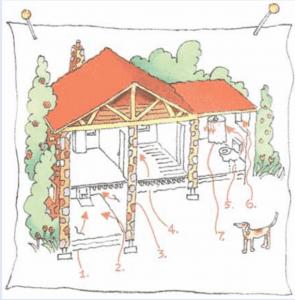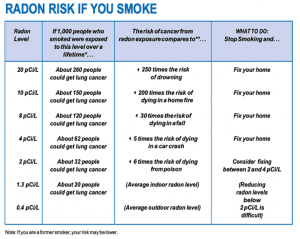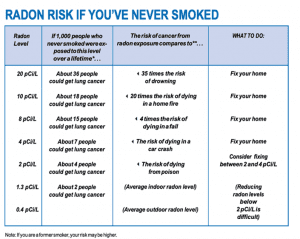This month is Radon Awareness Month, so we are spreading awareness of the danger of radon exposure and how to prevent it. Radon is a hazardous, radioactive gas that comes from rocks and soil, so it is important to take radon seriously year-round. While radon is most often found in the outside air, in some cases, it can build up inside your home. Our goal for you as a homeowner or business is to have the lowest radon level possible.
How does radon get in my home?

In the United States, almost 1 out of 15 homes suffer from elevated radon levels. Throughout our time as home inspectors, we have seen radon invade homes in many different ways. The most common way we’ve seen is radon moving through the ground into the air above. This causes radon to seep through the cracks and holes in your home’s foundation. Your home acts as a trap for radon, which will cause the radon levels to rise.
Radon can get into your home through the following:
• Cracks in the floors
• Construction joints
• Cracks in the wall
• Gaps in the floor
• Gaps in service pipes
• Wall cavities
• Water supplies
Any home can suffer from radon exposure, whether an old house, new home, well-sealed home, or drafty home, any home can suffer from radon exposure.
Where can radon be found?
The most common way radon enters your home is through the soil and the water supply. Radon entering your home through the soil usually poses a greater risk than radon that enters through your water supply; however, both need to be taken seriously. Research shows that your risk of lung cancer from breathing radon is much greater than the risk of stomach cancer from ingesting radon. However, radon that is found in your water can become a problem if it is released into the air. The radon found in your water can make its way into your air when you are showering, washing dishes, or any other time you are using your water. If you use a private well or public water supply, your risk of radon is much greater than other water supplies.
What are the dangers of radon in your home?
Radon can cause serious and deadly health issues by decaying into radioactive particles that can be trapped in your lungs as you breathe. These particles can cause damage to lung tissue and can lead to lung cancer. Approximately 130,180 Americans die from lung cancer each year, and according to the United States Environmental Protection Agency (EPA), radon is the leading cause of lung cancer for non-smokers. According to the EPA, scientists know more about radon risks than the risk of other cancer-causing substances. If you currently smoke or have smoked in the past, you can experience serious health issues when exposed to radon.


How can I take action?
The first step in protecting your home, business, or property from radon is to test for radon detection. The EPA recommends hiring a professional to test for radon in your home to ensure it is done properly and safely. We use professional equipment and technology, such as electronic monitoring, to test for radon levels throughout your home, so that we can ensure the safety of your family. Electronic monitoring is one of the most accurate and efficient forms of detection. Radon measurements can be short-term, long-term, or continuous, depending on the need and budget. If you experience unusual levels, continuous monitoring may be recommended. We are certified to conduct radon inspections to ensure that your family is kept safe from radon and the health issues that come with it.

Radon is a dangerous gas that can have lasting effects on you and your family. We have conducted countless inspections, so we are prepared to answer your questions if you would like to learn more about radon inspections for your home. If you want to ensure that you are protected, call us at (615) 481-7293.

